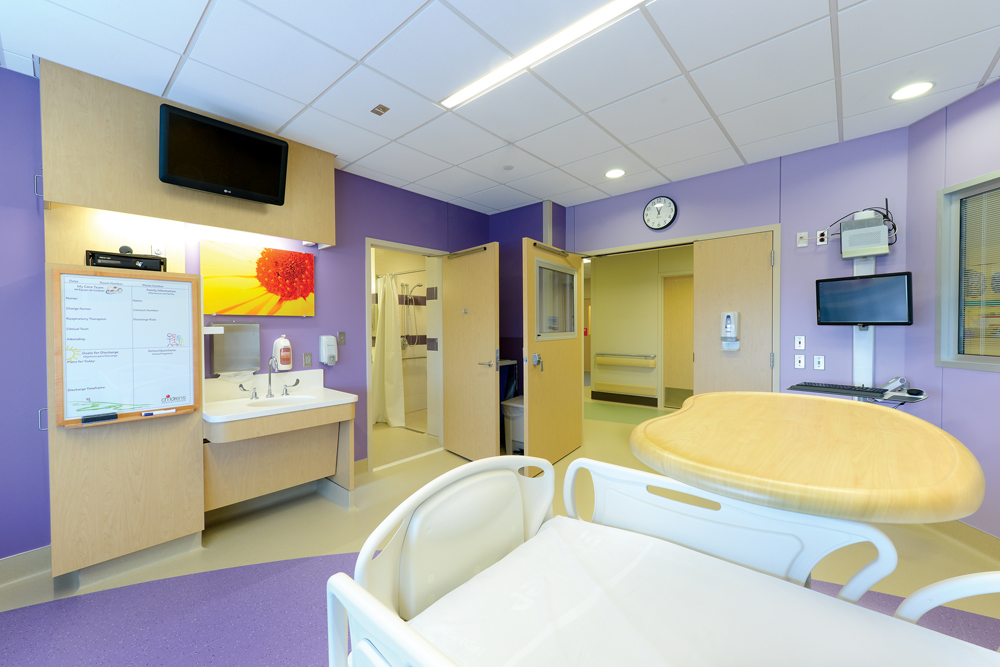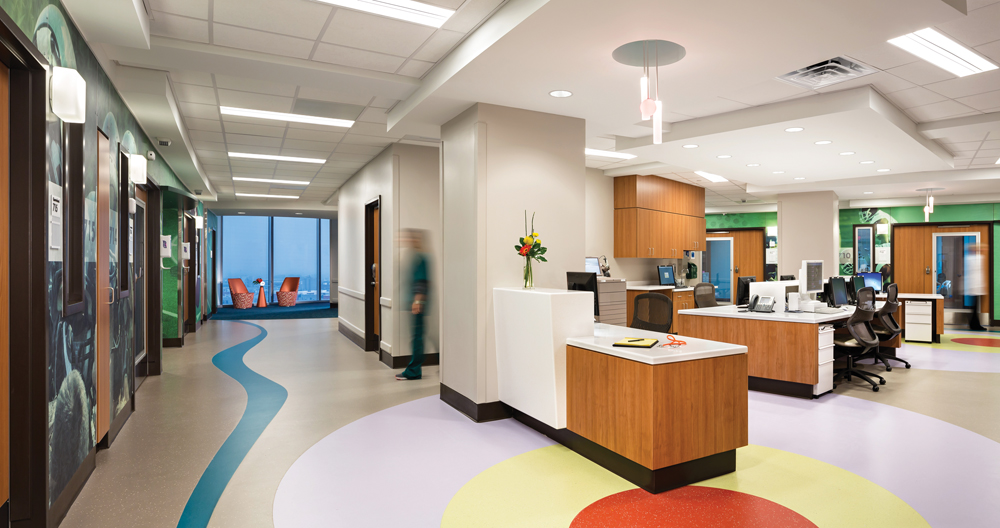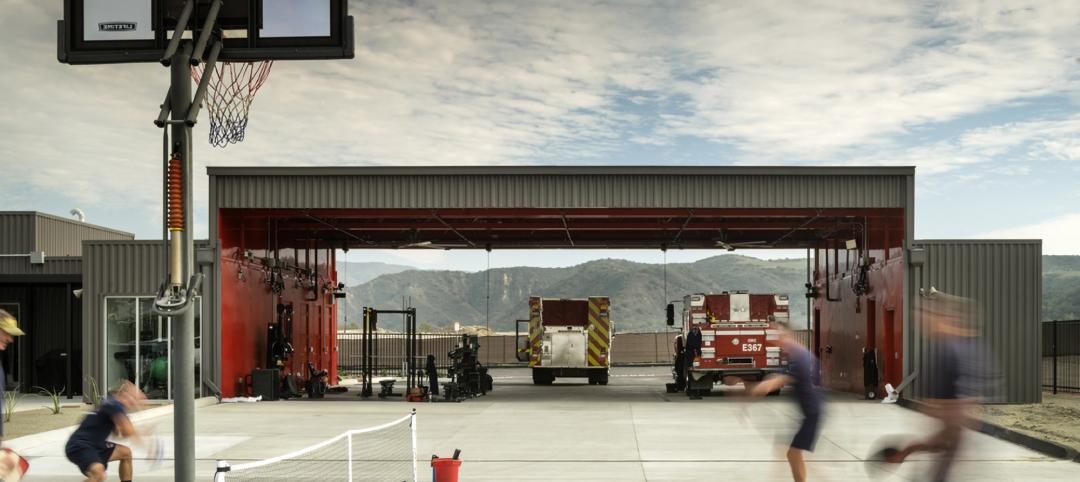Pediatric hospitals face many of the same concerns as their adult counterparts. The most consistent concern is change. Nationally, inpatient bed demand is declining, outpatient visits are soaring, and there is a higher level of focus on prevention and reduced readmissions.
The solution is not as simple as swapping inpatient space with outpatient care to meet the shifting demand. Many facilities have been operating 40% or more of their beds as semiprivates and—driven by reimbursement incentives for patient satisfaction and consumers’ penchant for choosing care based on public performance scores—hospital owners have no choice but to invest their limited capital dollars in new or renovated space to achieve 100% private-bed models.
In certificate of need (CON) states, owners are reluctant to reduce total bed counts due to the uncertainty in future bed demand. To effectively operate within this changing environment, owners look to the healthcare design and construction industry for creative facility solutions that offer highly flexible environments that promote healing.
Flexible Spaces, for Toddlers and Teens
Flexibility is key in helping owners address rapidly changing demands. While this is also true in adult care, children’s hospitals face a greater challenge due to the drastic difference in their patient dynamic. Caring for a patient in the NICU is significantly different than caring for a 16-year-old. Add the fact that pediatric inpatient volumes are sporadic at best, and you have an operational challenge in achieving ideal staff-to-patient ratios.
Children’s Medical Center Dallas has addressed uncertainty by designing patient rooms with a universal care model so they can be converted to ICU rooms with no construction impact. This will allow the hospital to flex with future trends.
Another way pediatric facilities are creating greater flexibility is by developing inpatient units that are more appropriate for all ages instead of just focusing on babies. In doing this, not only does the physical environment need to be highly adaptable to accommodate pediatric patients—i.e., adjustable sink heights, grab bars, and so on—but the design aesthetic must also evolve. Interiors need to move away from cutesy baby motifs to ones more appropriate for a wider age spectrum, from toddlers to teens.
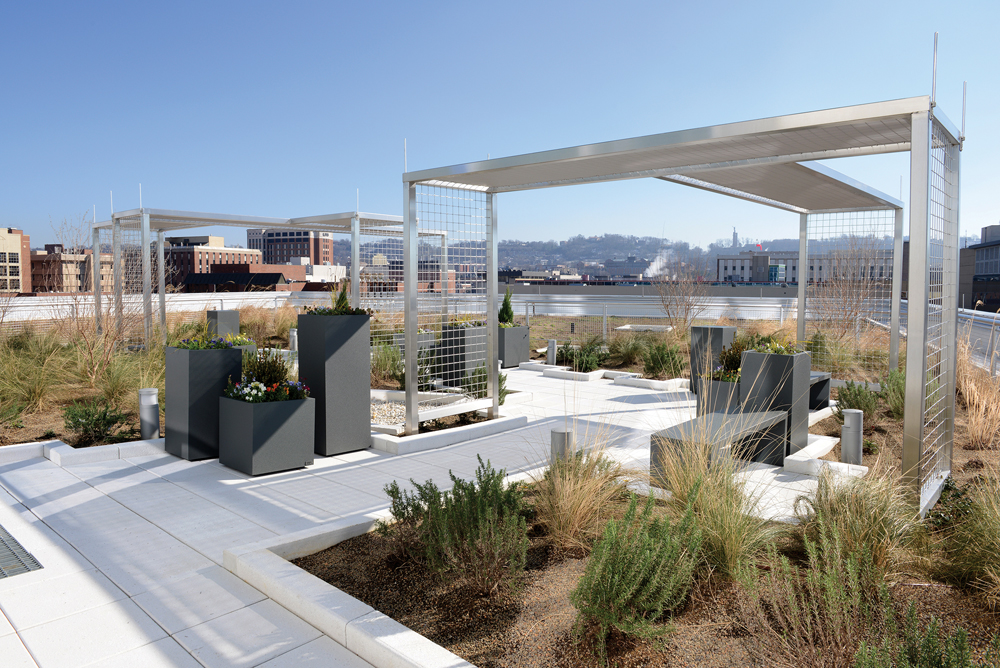
The rooftop garden provides a healing respite in an urban setting and is part of the LEED Gold-certified Benjamin Russell Hospital for Children’s environmentally friendly design.
Children’s of Alabama (COA) in Birmingham, Ala., was faced with these issues before opening its new facility, the Benjamin Russell Hospital for Children, in August 2013. To address these concerns, significant time was spent planning the design and “theme” for each floor. Wall surrounds and digital graphics portray wildlife, sports, nature, transportation, and other easy-to-remember themes. These were carried out in the hallways, common areas, and patient rooms. This strategy not only created a more inviting and comforting space for patients of all ages but also helped in the hospital’s wayfinding efforts. While a parent or child may not remember their room number, they would remember that they are in the “sports” tower, on the baseball floor, with a glove and ball by their room.
Tailoring the Healing Environment
Pediatric hospitals are not alone in their journey to becoming more patient-centered and family-focused, but the creative environments found in today’s children’s facilities puts them light years ahead of their adult-hospital peers. By engaging patients and their families in the design process, leaders are identifying what is most important for comfort and satisfaction.
Customization is increasingly popular. For example, integrating LED lights can enable patients to select their own wall and ceiling colors, giving them ultimate control over the look of their rooms. To further accommodate a broad age span, each patient room at COA is outfitted with an Xbox game console. These systems are tied into the hospital’s Patient Entertainment and Information System to provide an added layer of comfort. Patients, and more importantly their parents, are able to use the systems to research an illness, identify hospital services, and communicate with staff. One patient even commented, “Honestly, the hospital felt more like a hotel than a hospital.”
For larger pediatric units, playrooms for toddlers and teen rooms equipped with Wii stations offer on-unit destinations that allow patients a respite, inviting them to explore and to meet other children. Rooftop gardens are becoming more popular, making a bit of the outdoors accessible. COA’s rooftop garden, near the NICU, is designed to be a healing garden. The Building Team situated the “Quarterback” (West) Tower so that the end caps on each floor overlook Regions Field, home of the Birmingham Barons baseball team. On Friday nights, children can congregate at the end of the hall or in the garden to enjoy the weekly fireworks display.
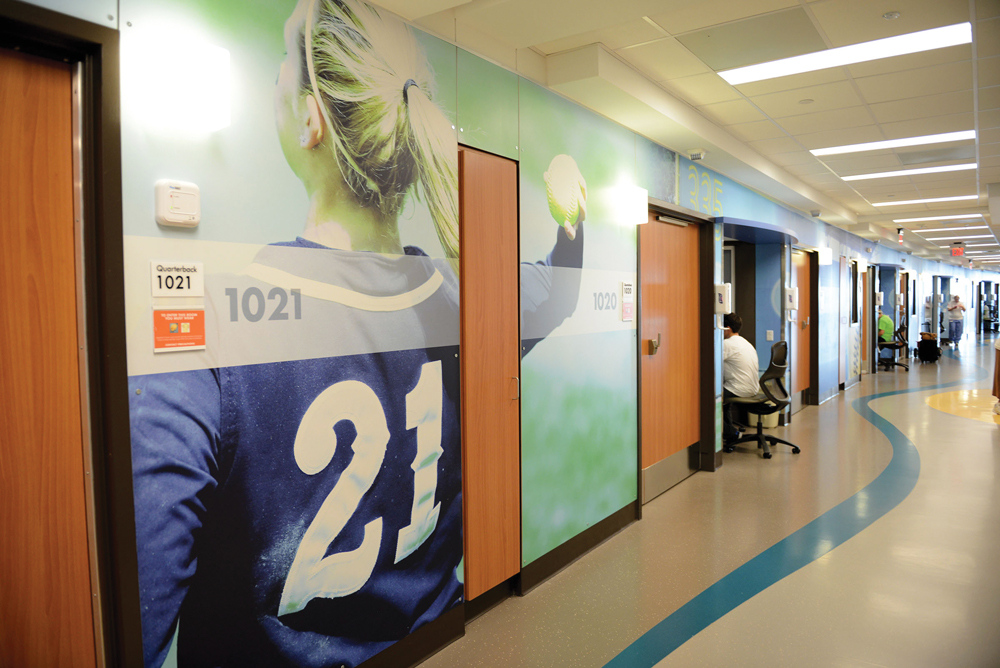
Family friendly themed wall-surrounds, vibrant colors, and a bold room numbering system combine with a wavy “blue river” pattern in the flooring at the Benjamin Russell Hospital for Children help patients and families with wayfinding.
Dedicated family space has also become very popular for children’s hospitals. “Family” zones, in patient rooms and in common areas, are designed to keep family members closer to their children, allowing for some privacy and comfort. The concept focuses on the family’s interaction with the hospital staff and their child to ensure a desirable flow. At design meetings, nursing staff often stress the importance of having a specific zone to accommodate parents within the patient room. In some instances, patient floors have been fitted with a family waiting area equipped with a kitchenette. This feature allows families to feel more at home during lengthy stays by giving them access to a refrigerator, sink, and microwave. Guest laundry areas may also be located on the unit for parent use.
Staff Space: Allow for Decompression
The distinctiveness of a children’s hospital transcends facility design. Staff play a critical role in the care and comfort of the children and their families. Staff often use the term “frequent flyers” to describe parents and children who must come to the hospital regularly for care. Even the security officers stationed at the door become very involved in the lives of these families and children. Staff at all levels, not just the caregivers, get to know the families and will go the extra mile to make their experience as pleasant and stress-free as possible.
Because the work is demanding, Building Teams should give special attention to the caregiver and staff areas of a pediatric facility. Make opportunities for staff to be “offstage” by providing inviting break areas, dining facilities, and outdoor spaces. These features enable staff to decompress during their workday, resulting in improved clinical performance when staff members are “onstage” caring for kids.
Hospitals are not typically envisioned as warm and inviting places. However, changes in design and care standards are creating spaces that provide patients and their families with much more comfort. From the outside “curb appeal” to the internal operations and systems, children’s hospitals are striving to achieve low-stress environments that aid in the healing and wellness of our smallest patients.
Staff spaces are open and comfortable, providing easy access to patient rooms. Glass end caps and sub-waiting areas at the end of each hallway provide expansive views of the city and Birmingham’s Regions Field at Children’s of Alabama.
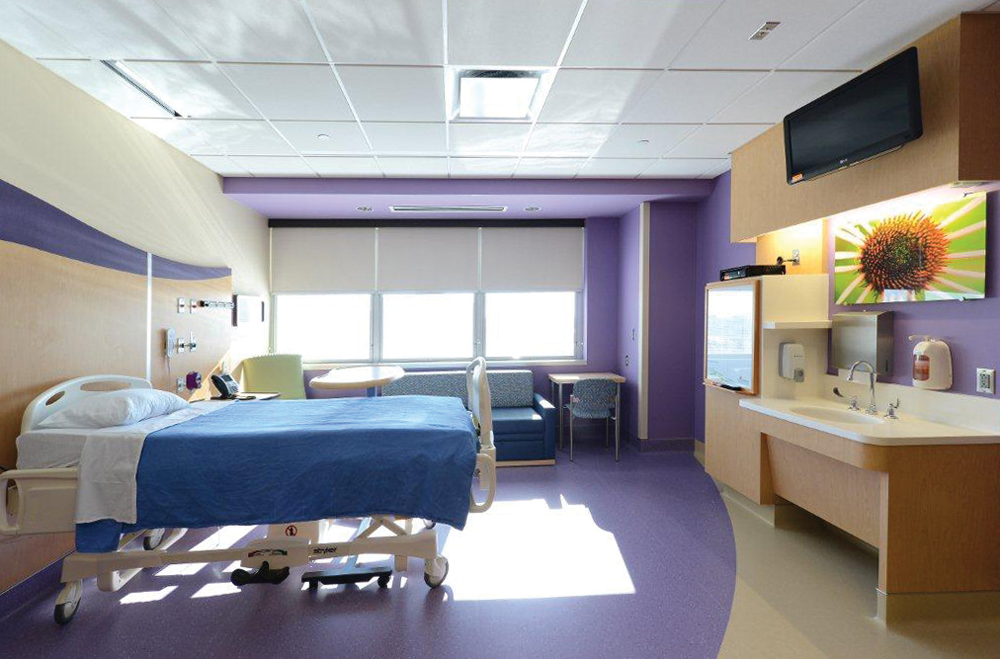
Spacious accommodations, warm aesthetics, and stimulating amenities aim to promote a relaxing environment for patients and their families throughout the healing process at Children’s Medical Center.
ABOUT THE AUTHORS
The authors of this article are affiliated with healthcare consulting firm CBRE Healthcare, based in Richmond, Va. They are Lora Schwartz, AIA, LEED AP, Principal; Stephen Powell, Consultant; Brad Durham, MBA, Principal; Magnus Nilsson, RA, Senior Consultant; Steven Donnelly, Vice President; and Curtis Skolnick, MHA, Vice President.
Related Stories
Giants 400 | Feb 8, 2024
Top 10 Telecommunications Building Architecture Firms for 2023
Arcadis North America, CSArch, Interior Architects, and TETER top BD+C's ranking of the nation's largest telecommunications building architecture and architecture/engineering (AE) firms for 2023, as reported in Building Design+Construction's 2023 Giants 400 Report.
Giants 400 | Feb 8, 2024
Top 50 Public Library Architecture Firms for 2023
Quinn Evans, McMillan Pazdan Smith, PGAL, Skidmore, Owings & Merrill, and Gensler top BD+C's ranking of the nation's largest public library architecture and architecture/engineering (AE) firms for 2023, as reported in Building Design+Construction's 2023 Giants 400 Report.
Giants 400 | Feb 8, 2024
Top 60 Performing Arts Center and Concert Venue Architecture Firms for 2023
Populous, DLR Group, Gensler, HGA, and Perkins Eastman top BD+C's ranking of the nation's largest performing arts center and concert venue architecture and architecture/engineering (AE) firms for 2023, as reported in Building Design+Construction's 2023 Giants 400 Report.
Giants 400 | Feb 8, 2024
Top 70 Museum Architecture Firms for 2023
SmithGroup, Gensler, Ayers Saint Gross, Quinn Evans, HGA, and Cooper Robertson head BD+C's ranking of the nation's largest museum and gallery architecture and architecture/engineering (AE) firms for 2023, as reported in Building Design+Construction's 2023 Giants 400 Report.
Architects | Feb 8, 2024
LPA President Dan Heinfeld announced retirement
LPA Design Studios announced the upcoming retirement of longtime president Dan Heinfeld, who led the firm’s growth from a small, commercial development-focused architecture studio into a nation-leading integrated design practice setting new standards for performance and design excellence.
Market Data | Feb 7, 2024
New download: BD+C's February 2024 Market Intelligence Report
Building Design+Construction's monthly Market Intelligence Report offers a snapshot of the health of the U.S. building construction industry, including the commercial, multifamily, institutional, and industrial building sectors. This report tracks the latest metrics related to construction spending, demand for design services, contractor backlogs, and material price trends.
Giants 400 | Feb 6, 2024
Top 80 Religious Facility Architecture Firms for 2023
Parkhill, FGM Architects, GFF, Gensler, and HOK top BD+C's ranking of the nation's largest religious facility architecture and architecture engineering (AE) firms for 2023, as reported in the 2023 Giants 400 Report.
Modular Building | Feb 6, 2024
Modular fire station allows for possible future reconfigurations
A fire station in Southern California leveraged prefab, modular construction for faster completion and future reconfiguration.
Giants 400 | Feb 5, 2024
Top 30 Entertainment Center, Cineplex, and Theme Park Architecture Firms for 2023
Gensler, JLL, Nelson Worldwide, AO, and Stantec top BD+C's ranking of the nation's largest entertainment center, cineplex, and theme park architecture and architecture engineering (AE) firms for 2023, as reported in the 2023 Giants 400 Report.
Urban Planning | Feb 5, 2024
Lessons learned from 70 years of building cities
As Sasaki looks back on 70 years of practice, we’re also looking to the future of cities. While we can’t predict what will be, we do know the needs of cities are as diverse as their scale, climate, economy, governance, and culture.


